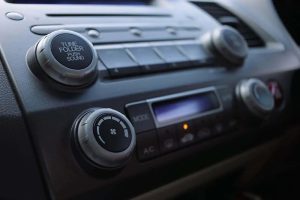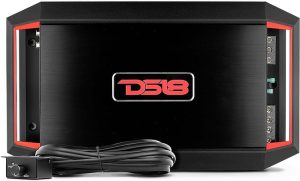Car audio enthusiasts chase the thrill of deep, booming bass that shakes the seats and brings music to life. You’ve likely invested time and money into your setup, carefully selecting speakers, subwoofers, and amplifiers to create the perfect sound. But what happens when your amplifier packs more power than your subwoofer can handle? This mismatch can spell trouble for your audio system, leading to distorted sound, damaged equipment, or a disappointing listening experience. Don’t worry—this guide breaks down the risks of an overpowered amp, offers practical solutions, and shares tips to keep your car audio system pumping out crystal-clear bass for years to come.
Contents
- Why Matching Your Amp and Subwoofer Matters
- The Dangers of an Overpowered Amplifier
- How to Tell If Your Amp Is Too Powerful
- Solutions for an Overpowered Amplifier
- Tips to Prevent Mismatching in the Future
- Common Myths About Amp and Subwoofer Power
- Enhancing Your Car Audio Experience
- Wrapping Up: Protect Your Subwoofer, Amplify Your Sound
Why Matching Your Amp and Subwoofer Matters
Before diving into the consequences of an overpowered amp, let’s clarify why matching your amplifier and subwoofer is critical. A subwoofer handles low-frequency sounds, delivering the deep bass that makes your music feel alive. The amplifier powers the sub, sending electrical signals to drive the speaker’s cone and produce sound. Each subwoofer has a power rating, typically measured in watts RMS (Root Mean Square), which indicates the continuous power it can handle without damage. Amplifiers also have a power rating, showing how much wattage they can deliver to the sub.
When the amp’s power output exceeds the subwoofer’s RMS rating, you’re playing a risky game. Too much power can push the sub beyond its limits, causing mechanical or thermal failure. On the flip side, an underpowered amp might leave your subwoofer sounding weak, unable to reach its full potential. Striking the right balance ensures optimal sound quality and protects your investment. Now, let’s explore what happens when your amp is too powerful and how to fix it.
The Dangers of an Overpowered Amplifier
Pairing a high-powered amp with a subwoofer that can’t handle the load invites a host of problems. Here’s a closer look at the potential consequences:
1. Overheating and Thermal Damage
Subwoofers rely on voice coils—wire coils that move the speaker cone—to produce sound. When an amp sends too much power, the voice coils work overtime, generating excessive heat. If the subwoofer isn’t designed to dissipate this heat, the coils can burn out, rendering the sub useless. Overheating doesn’t always happen instantly; repeated exposure to excessive power can weaken the coils over time, leading to sudden failure during a loud track.
2. Mechanical Failure
Too much power can also cause mechanical damage. The subwoofer’s cone and suspension system (the surround and spider) are built to handle a specific range of movement. An overpowered amp can force the cone to move beyond its limits,unstated, causing the cone to tear or the suspension to break. This overexcursion can destroy the subwoofer, leaving you with a costly repair or replacement.
3. Distorted Sound Quality
Even if the subwoofer survives, an overpowered amp can degrade your listening experience. Excessive power often leads to clipping, where the amp distorts the audio signal because it can’t deliver clean power at high volumes. This results in harsh, muddy bass that ruins the clarity of your music. Instead of tight, punchy low-end, you get a distorted mess that’s far from enjoyable.
4. Electrical Strain
An amp pumping out more power than necessary puts stress on your car’s electrical system. The alternator and battery work harder to supply the extra juice, which can lead to blown fuses, tripped circuit breakers, or even damage to the amp itself. This strain can also shorten the lifespan of your electrical components, adding unexpected repair costs.
5. Ruptured Subwoofer Cones
In extreme cases, an overpowered amp can physically tear the subwoofer’s cone. The excessive force from the amp causes the cone to flex beyond its design, leading to cracks or complete ruptures. Once the cone is damaged, the subwoofer’s performance tanks, and replacement becomes the only option.
How to Tell If Your Amp Is Too Powerful
Wondering if your amp is overpowering your sub? Watch for these warning signs:
- Distorted Bass: If the bass sounds harsh, fuzzy, or unclear, your amp might be clipping or sending too much power.
- Excessive Heat: After playing music, check if the subwoofer or amp feels unusually hot. Warmth is normal, but scorching temperatures signal trouble.
- Subwoofer Bottoming Out: A loud clacking or popping sound during heavy bass tracks suggests the sub is overextending, a sign of too much power.
- Frequent Electrical Issues: Blown fuses or a drained battery could indicate the amp is drawing more power than your system can handle.
If you notice these symptoms, act quickly to prevent damage. Let’s explore practical solutions to balance your setup and protect your subwoofer.
Solutions for an Overpowered Amplifier
Realizing your amp is too powerful doesn’t mean you need to scrap your setup. Here are actionable steps to bring harmony to your car audio system:
1. Adjust the Amplifier’s Gain Settings
Most amplifiers have a gain control that adjusts the amount of power sent to the subwoofer. Lowering the gain reduces the output, helping match the amp’s power to the sub’s RMS rating. To set the gain properly, play a test tone (like a 40Hz sine wave) and use a multimeter to measure the amp’s output voltage. Adjust the gain until the voltage aligns with the subwoofer’s RMS power rating. This method ensures clean power delivery without overloading the sub. If you’re unsure how to do this, consult a professional installer for precise tuning.
2. Use a Subwoofer with a Built-In Amplifier
Consider switching to an active subwoofer with a built-in amplifier. These units are designed with perfectly matched components, eliminating the risk of overpowering. Active subwoofers simplify installation and ensure the amp and sub work in sync, delivering clean bass without the guesswork. They’re ideal for beginners or anyone seeking a hassle-free solution.
3. Upgrade Your Subwoofer
If your budget allows, upgrade to a subwoofer with a higher RMS power rating that matches or exceeds your amp’s output. Check the sub’s specifications before buying to confirm compatibility. A beefier sub can handle the amp’s power, letting you crank up the volume without fear of damage. This option also improves bass output, giving you deeper, more impactful low-end for a richer listening experience.
4. Install a Limiter or Crossover
Signal processing tools like limiters and crossovers can protect your subwoofer. A limiter caps the power sent to the sub, preventing it from exceeding the RMS rating. A crossover filters out frequencies the subwoofer isn’t designed to handle, reducing strain on the speaker. These devices add an extra layer of safety, ensuring your sub stays within its limits even during intense bass-heavy tracks.
5. Rewire for Higher Impedance
Subwoofers and amps interact based on impedance, measured in ohms. Wiring your subwoofer to present a higher impedance load (e.g., 4 ohms instead of 2 ohms) reduces the amp’s power output. Check your amp’s manual to see how its wattage changes at different impedance levels, then rewire the sub accordingly. This trick effectively tames an overpowered amp without needing new equipment.
6. Consult a Professional
If tweaking settings or rewiring feels overwhelming, enlist a car audio expert. Professionals can assess your system, tune the amp, and recommend upgrades or adjustments tailored to your setup. Their expertise saves time and prevents costly mistakes, ensuring your system sounds great and lasts longer.
Tips to Prevent Mismatching in the Future
Avoid the headache of an overpowered amp by planning your system carefully. Here’s how to get it right from the start:
- Match RMS Ratings: Choose an amp with an RMS output between 75% and 150% of your subwoofer’s RMS rating. This range provides enough power for strong bass without risking damage.
- Check Impedance Compatibility: Ensure the subwoofer’s impedance (e.g., 2 ohms, 4 ohms) aligns with the amp’s capabilities. Use wiring diagrams to achieve the desired impedance load.
- Research Before Buying: Read reviews, compare specs, and consult forums like Reddit’s r/CarAV or DIYMobileAudio.com for real-world advice on amp-sub pairings.
- Test Your Setup: After installation, play music at moderate volumes and listen for distortion or mechanical noises. Gradually increase the volume to find the system’s limits.
- Invest in Quality Components: High-quality subwoofers and amps from reputable brands like JL Audio, Alpine, or Rockford Fosgate often include better protection circuits and clearer specs, reducing the risk of mismatches.
Common Myths About Amp and Subwoofer Power
Misinformation about car audio can lead to poor decisions. Let’s debunk a few myths:
- Myth: More Watts Always Means Better Bass
Truth: Bass quality depends on the subwoofer’s design, enclosure type, and amp tuning, not just wattage. A well-matched 500W system can outperform a poorly tuned 1000W setup. - Myth: An Overpowered Amp Always Blows the Sub
Truth: With proper gain settings and careful tuning, an overpowered amp can work safely with a lower-rated sub. The key is controlling the power output. - Myth: Underpowering Is Safer Than Overpowering
Truth: Underpowering can cause clipping, sending distorted signals that damage the subwoofer. Both extremes are risky without proper setup.
Enhancing Your Car Audio Experience
A balanced amp and subwoofer setup is just the start. To take your car audio to the next level, consider these upgrades:
- Sound Deadening: Apply sound-deadening mats to your car’s doors and trunk to reduce rattles and enhance bass clarity.
- Custom Enclosure: Build a sealed or ported subwoofer box tailored to your sub’s specs for tighter, deeper bass.
- Equalizer Tuning: Use a digital signal processor (DSP) to fine-tune frequencies, ensuring your sub blends seamlessly with your speakers.
- High-Quality Wiring: Use thick, oxygen-free copper wiring to minimize power loss and maintain consistent performance.
Wrapping Up: Protect Your Subwoofer, Amplify Your Sound
An amplifier that’s too powerful for your subwoofer can lead to overheating, mechanical failure, distorted sound, or electrical strain. But with the right adjustments—like tuning the gain, rewiring for higher impedance, or upgrading your sub—you can protect your system and enjoy heart-pounding bass. Take the time to match your components, monitor for warning signs, and consult professionals when needed. By building a balanced setup, you’ll create a car audio system that delivers powerful, clean sound for every drive.
Ready to optimize your car audio? Check your subwoofer and amp specs, make the necessary tweaks, and hit the road with confidence. For more tips on car stereo setups, explore trusted resources like Auto Stereo Guide or connect with enthusiasts on forums like DIYMobileAudio.com. Your perfect bass experience is just a tune-up away!






